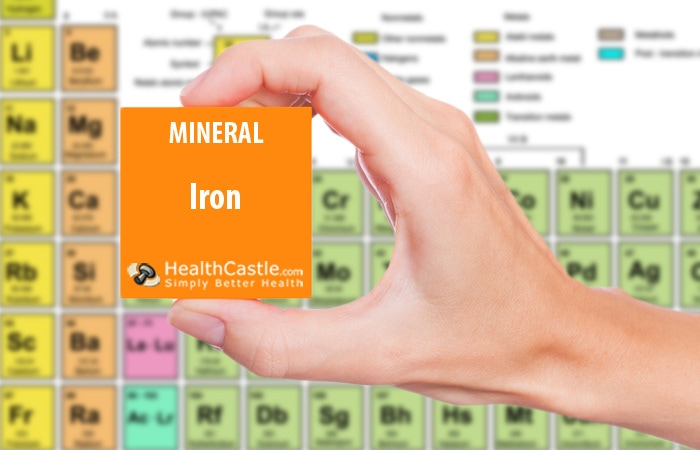
Written By: Sofia Layarda, MPH
Title: Master of Public Health
Alumni: University of California, Berkeley
Last Updated on:


Iron is an important mineral for our bodies. Iron is a part of the oxygen-carrying component of our blood, hemoglobin. There are two forms of iron used in supplements: ferrous and ferric. Ferrous iron is better absorbed. Common forms of ferrous iron supplements are ferrous fumarate, ferrous sulfate, and ferrous gluconate.
Table of Contents
The Dietary Reference Intakes (DRI) for iron are shown below:
| Age Group | Recommended Dietary Allowance (RDA) per Day | Tolerable Upper Intake Level (UL) per Day | |
| Adults | Male: | Female: | |
| 19 to 50 years | 8 mg | 18 mg | 45 mg |
| 51 to 70 years | 8 mg | 8 mg | 45 mg |
| 71 years and up | 8 mg | 8 mg | 45 mg |
| Kids and Youth | |||
| 1 to 3 years | 7 mg | 7 mg | 40 mg |
| 4 to 8 years | 10 mg | 10 mg | 40 mg |
| 9 to 13 years | 8 mg | 8 mg | 40 mg |
| 14 to 18 years | 11 mg | 15 mg | 45 mg |
| Special Considerations | |||
| Pregnant women 14 to 18 years | 27 mg | 45 mg | |
| Lactating women 14 to 18 years | 10 mg | 45 mg | |
| Pregnant women 19 to 50 years | 27 mg | 45 mg | |
| Lactating women 19 to 50 years | 9 mg | 45 mg | |
Healthy full-term infants are born with iron stores that last from four to six months. There is not sufficient evidence to recommend an RDA level for infants from birth through six months. Iron in breast milk is absorbed very well compared to iron in infant formulas. Premature infants are at risk for iron deficiency and may be prescribed an iron supplement by their pediatrician.
Iron is an integral part of hemoglobin, the oxygen-carrying component of blood. Iron helps our muscles store and use oxygen, and is a part of many enzymes involved in metabolic processes in the body. When your iron levels are too low, you can either have iron deficiency (low iron levels without functional impairment) or iron deficiency anemia (where the iron levels are low enough to cause symptoms such as motor or mental developmental delays among infants, or memory problems, fatigue, or low energy among adults). The iron needs of pregnant women are approximately double the requirements for non-pregnant women because of increased blood volume, increased blood flow to the fetus, and blood loss during delivery. If a pregnant woman has iron deficiency anemia, there is increased risk of premature delivery or having a low birth weight baby.
In the foods we eat, iron exists in two forms: heme and non-heme. Heme iron comes from animal sources, while non-heme iron comes from plant-based sources. Heme iron is better absorbed by the body, so those who do not eat animal foods must take some extra steps to ensure they are getting enough iron from the foods they eat. The iron used to fortify foods such as breakfast cereals is also the non-heme type.
Vitamin C–rich foods enhance iron absorption. In addition, if a food high in heme iron is consumed with a non-heme iron source, the overall iron absorption is enhanced.
| Food | Iron per Serving |
| Clams, 3 oz | 23.8 mg |
| Whole grain breakfast cereals, 1 cup | Wide range. Examples:
|
| Pumpkin seeds, 1/4 cup | 8.6 mg |
| Firm tofu, 3/4 cup | 8 mg |
| Oysters, 3 oz | 7.8 mg |
| White beans, cooked, 3/4 cup | 5.8 mg |
| Lentils, cooked, 3/4 cup | 4.9 mg |
| Red kidney beans, cooked, 3/4 cup | 3.9 mg |
| Blackstrap molasses, 1 tbsp | 3.6 mg |
| Prune juice, 1 cup | 3.2 mg |
| Beef, 3 oz | 1.6 mg to 2.5 mg |
| Lamb chop, 3 oz | 2.1 mg |
In the US: The daily value for iron is 18 mg, which is the same level as the DRI for women aged 19 to 50. The % daily value gives you an idea of how much iron is in the food you eat. The number you see on the Nutrition Facts label is a percentage calculated by dividing the amount of iron in one serving of the food by the daily value. So, for example, a serving of breakfast cereal that contains 9 mg of iron would have 50% of the daily value (DV) for iron.
In Canada: The daily value for iron is 14 mg, which is roughly halfway between the DRI levels for an adult male and for an adult female. Using the same example, a breakfast cereal containing 9 mg of iron per serving would be labeled as containing 64% DV.
Zinc: Iron supplements may interfere with zinc absorption. However, taking the supplements with food helps mitigate the effect.
Oxalic acid or oxalate: Oxalic acid is found in foods such as beans, nuts, spinach, amaranth, and chard; it is known to inhibit iron absorption.
Calcium: Calcium-rich foods may interfere with iron absorption.
Vitamin C: Vitamin C helps enhance the absorption of iron from foods.
Alumni: University of California, Berkeley – Sofia believes in bringing back fun and pleasure into everyday eating. She loves cooking, and is constantly experimenting with ingredients, creating recipes and trying them out on family and friends. Her latest interest lies in finding realistic and practical ways of environmentally-friendly food/eating habits.
iron, kid's nutrition, micronutrient - minerals, minerals, nutrients, pregnancy, vitamins - minerals